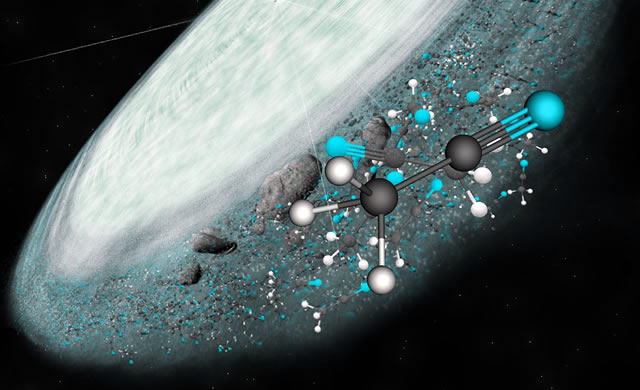
Per la prima volta gli astronomi hanno scoperto la presenza di molecole organiche complesse, i mattoni della vita, in un disco protoplanetario che circonda una giovane stella. La scoperta, realizzata con ALMA (Atacama Large Millimeter/submillimeter Array), riconferma che le condizioni in cui hanno avuto origine la Terra e il Sole non sono uniche nell’Universo. I risultati vengono pubblicati nel numero del 9 aprile 2015 della rivista Nature.
Le nuove osservazioni con ALMA rivelano che il disco protoplanetario che circonda la giovane stella MWC 480 contiene grandi quantità di cianuro di metile (CH3CN, detto anche etanonitrile), una molecola complessa a base di carbonio. Intorno a MWC 480 si trova abbastanza cianuro di metile per riempire tutti gli oceani della Terra. Sia questa molecola che la sua cugina più semplice, l’acido cianidrico (HCN, noto anche come acido prussico) sono stati trovati nelle zone esterne e gelide del disco appena formato, nella regione che gli astronomi ritengono analoga alla fascia di Kuiper – il regno dei planetesimi ghiacciati e delle comete nel nostro Sistema Solare, oltre Nettuno. Le comete mantengono l’impronta incontaminata della chimica primitiva del Sistema Solare del periodo della formazione planetaria. Si pensa che comete e asteroidi dalle zone esterne del Sistema Solare abbiano portato sulla giovane Terra acqua e molecole organiche, aiutando a porre le basi per lo sviluppo della vita primordiale. “Studi di comete e asteroidi mostrano che la nebulosa che ha dato origine al Sole e ai pianeti era ricca di acqua e composti organici complessi”, osserva Karin Öberg, astronoma all’Harvard-Smithsonian Center for Astrophysics a Cambridge, Massachussetts, USA, prima autrice dell’articolo. “Abbiamo ora indizi ancora più chiari che questa stessa chimica sia presente in altri luoghi nell’Universo, in regioni che potrebbero formare sistemi planetari simili al nostro”. Ciò è particolarmente interessante, secondo Öberg, perchè le molecole trovate in MWC 480 si trovano in concentrazioni simili nelle comete del Sistema Solare.
Fonte/Leggi tutto → ESO.org
For the first time, astronomers have detected the presence of complex organic molecules, the building blocks of life, in a protoplanetary disc surrounding a young star. The discovery, made with the Atacama Large Millimeter/submillimeter Array (ALMA), reaffirms that the conditions that spawned the Earth and Sun are not unique in the Universe. The results are published in the 9 April 2015 issue of the journal Nature.
The new ALMA observations reveal that the protoplanetary disc surrounding the young star MWC 480 [1] contains large amounts of methyl cyanide (CH3CN), a complex carbon-based molecule. There is enough methyl cyanide around MWC 480 to fill all of Earth’s oceans. Both this molecule and its simpler cousin hydrogen cyanide (HCN) were found in the cold outer reaches of the star’s newly formed disc, in a region that astronomers believe is analogous to the Kuiper Belt — the realm of icy planetesimals and comets in our own Solar System beyond Neptune. Comets retain a pristine record of the early chemistry of the Solar System, from the period of planet formation. Comets and asteroids from the outer Solar System are thought to have seeded the young Earth with water and organic molecules, helping set the stage for the development of primordial life. “Studies of comets and asteroids show that the solar nebula that spawned the Sun and planets was rich in water and complex organic compounds,” noted Karin Öberg, an astronomer with the Harvard-Smithsonian Center for Astrophysics in Cambridge, Massachusetts, USA, and lead author of the new paper. “We now have even better evidence that this same chemistry exists elsewhere in the Universe, in regions that could form solar systems not unlike our own.” This is particularly intriguing, Öberg notes, since the molecules found in MWC 480 are also found in similar concentrations in the Solar System’s comets. The star MWC 480, which is about twice the mass of the Sun, is located 455 light-years away in the Taurus star-forming region. Its surrounding disc is in the very early stages of development — having recently coalesced out of a cold, dark nebula of dust and gas. Studies with ALMA and other telescopes have yet to detect any obvious signs of planet formation in it, although higher resolution observations may reveal structures similar to HL Tauri, which is of a similar age. Astronomers have known for some time that cold, dark interstellar clouds are very efficient factories for complex organic molecules — including a group of molecules known as cyanides. Cyanides, and most especially methyl cyanide, are important because they contain carbon–nitrogen bonds, which are essential for the formation of amino acids, the foundation of proteins and the building blocks of life. Until now, it has remained unclear, however, if these same complex organic molecules commonly form and survive in the energetic environment of a newly forming solar system, where shocks and radiation can easily break chemical bonds.
Source/Continue reading → ESO.org





















